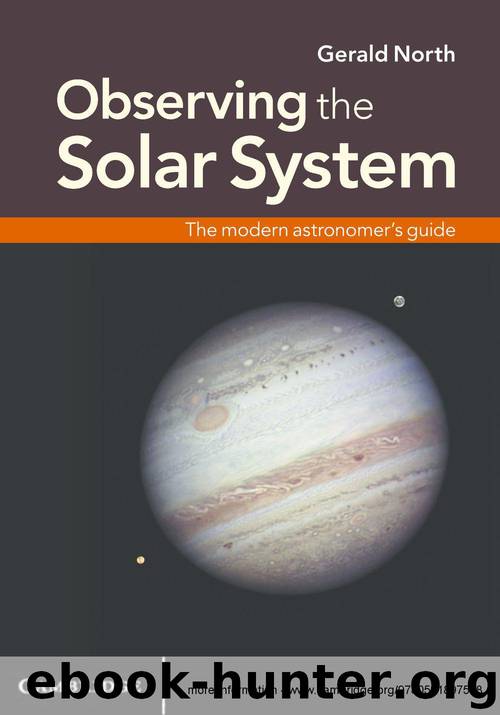Observing the Solar System by North Gerald

Author:North, Gerald [North, Gerald]
Language: eng
Format: azw3
Publisher: Cambridge University Press
Published: 2012-10-30T16:00:00+00:00
As you will see from the figures presented in this chapter, the GRS is somewhat changeable in its appearance. At some times the GRS is the darkest feature on the planet, then taking on a strong reddish hue, while at other times it becomes virtually invisible but leaves a white hollow in its place. Sometimes the GRS and its hollow can appear together, the GRS being slightly separated or displaced from it – a weird effect. I well remember the strikingly vivid reddish-magenta hue of the GRS in the early to mid 1970s as seen through my childhood 3-inch (76 mm) Newtonian reflector. I also remember finding it very pale and hard to see through my 18¼-inch (0.46 m) telescope early in the 1980s. The spot has darkened again since, but is still not as prominent as it was in the 1970s. In the last few years, its colour has seemed to me to be more of a muted brownish-orange rather than red. A recent change is that it has developed a darkish spot at its centre and a mildly dark rim at its edge. At the time of writing its colour has deepened once more to a strong orange, a change that has been seen before to accompany an episode of fading and subsequent re-emergence of the SEB.
Historical records show that the GRS was at its largest in the 1880s, but by the 1980s had shrunk to a length of about 26 000 km. This is about half its former value. Its width had remained fairly constant during that period at about 14 000 km, and so it became very much less elliptical than it used to be. In recent years it has shrunk some more, this time in width as well as length. Its width is now about 10 000 km and its length about 17 000 km. What changes will the next decades bring? Its current strong orange hue is probably transient. Are we witnessing the slow demise of this feature or will it one day suddenly re-invigorate to something like its nineteenth-century splendour?
Spectral analysis from the Earth showed the presence of large amounts of hydrogen, methane and ammonia in the atmosphere of Jupiter, and infrared measures had indicated that the average cloud-top temperature is in the region of –130°C. The GRS shows up as a particularly cold spot. Many theories were concocted to explain the appearance and longevity of the feature, but observations from space probes were required before we really could begin to make sense of it.
Download
This site does not store any files on its server. We only index and link to content provided by other sites. Please contact the content providers to delete copyright contents if any and email us, we'll remove relevant links or contents immediately.
Tools of Titans by Timothy Ferriss(8215)
Turbulence by E. J. Noyes(7935)
Secrets of Antigravity Propulsion: Tesla, UFOs, and Classified Aerospace Technology by Ph.D. Paul A. Laviolette(5309)
Astrophysics for People in a Hurry by Neil DeGrasse Tyson(5130)
Room 212 by Kate Stewart(5035)
Design of Trajectory Optimization Approach for Space Maneuver Vehicle Skip Entry Problems by Runqi Chai & Al Savvaris & Antonios Tsourdos & Senchun Chai(5011)
Pale Blue Dot by Carl Sagan(4908)
The David Icke Guide to the Global Conspiracy (and how to end it) by David Icke(4624)
A Journey Through Divination and Astronomy by Publishing Pottermore(4342)
Goodbye Paradise(3726)
Apollo 8 by Jeffrey Kluger(3635)
COSMOS by Carl Sagan(3553)
Losing the Nobel Prize by Brian Keating(3498)
The Five People You Meet in Heaven by Mitch Albom(3474)
How to Read Water: Clues and Patterns from Puddles to the Sea (Natural Navigation) by Tristan Gooley(3406)
Brief Answers to the Big Questions by Stephen Hawking(3369)
How to Read Nature by Tristan Gooley(3249)
The Order of Time by Carlo Rovelli(3145)
A Brief History of Time by Stephen Hawking(2959)
